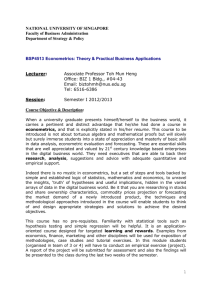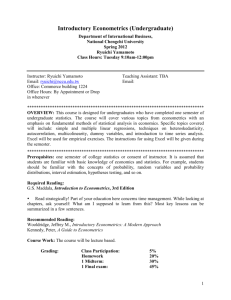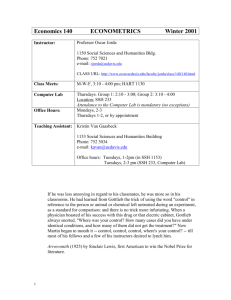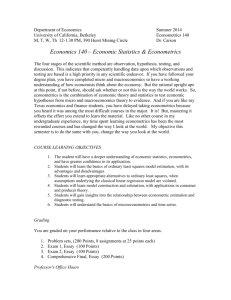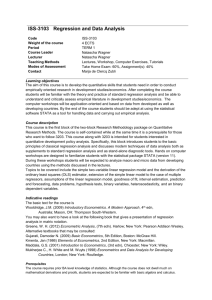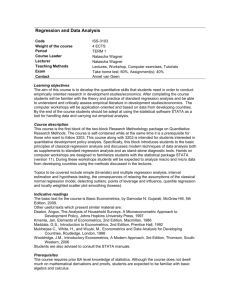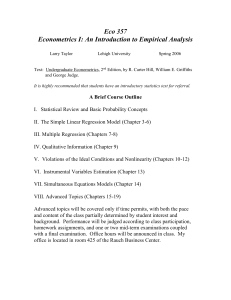Econometrics
advertisement
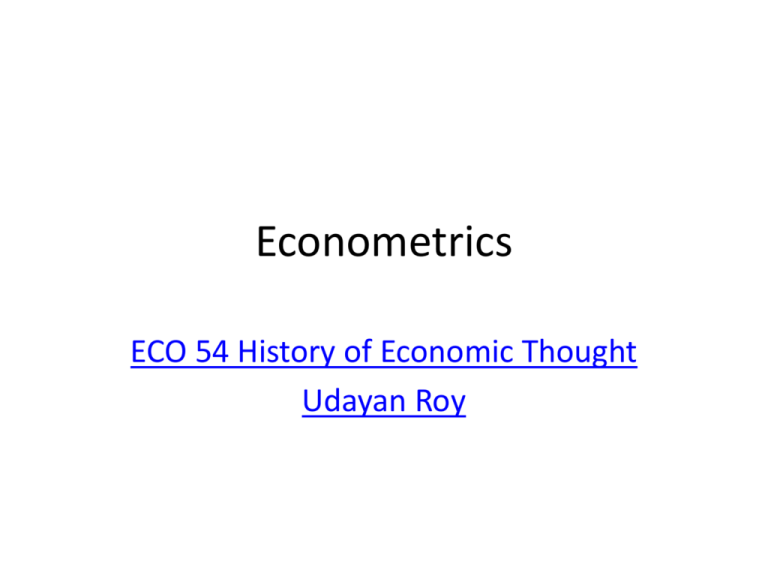
Econometrics ECO 54 History of Economic Thought Udayan Roy What is Econometrics? • Econometrics literally means ‘economic measurement’. • Here is how Ragnar Frisch (1895 – 1973), one of the founders of the subject, defined econometrics: – Thus, econometrics is by no means the same as economic statistics. Nor is it identical with what we call general economic theory, although a considerable portion of this theory has a definitely quantitative character. Nor should econometrics be taken as synonymous with the application of mathematics to economics. Experience has shown that each of these three viewpoints, that of statistics, economic theory, and mathematics, is a necessary, but not by itself sufficient, condition for a real understanding of the quantitative relations in modern economic life. It is the unification of all three that is powerful. And it is this unification that constitutes econometrics. (‘Editorial’, Econometrica, vol. 1, 1933, p. 2) What is Econometrics? • Theoretical economic analysis, no matter how mathematical its style, is not econometrics. • The accumulation of statistical measurements is not econometrics. • Probability theory is not econometrics either. What is Econometrics? • Econometrics is the use of statistical measurements to test the validity of mathematically expressed economic theories in the light of the laws of probability theory. What is Econometrics? • The goal of econometric analysis is to make reliable quantitative predictions of the likely responses of the economy to alternative economic policies and shocks. • Such predictions, if available, would be a useful guide for policymakers. Application: Supply and Demand • Let us take the familiar theory of supply and demand and see how it might be tested using observed data Application: Supply and Demand • The supply-demand theory consists of three assumptions: – Demand: The quantity of a product that is demanded by buyers is inversely related to the product’s price, assuming all other factors that also affect buyers’ decisions are unchanged. – Supply: The quantity of a product that is supplied by sellers is directly related to the product’s price, assuming all other factors that also affect sellers’ decisions are unchanged. – Equilibrium: The product’s price is always at the level that makes the quantity supplied equal to the quantity demanded. Application: Supply and Demand • The econometrician will have to test each assumption with data. • Valid statistical techniques based on the standard laws of probability will have to be used to test whether the available data does indeed imply an inverse relation between price and quantity demanded when all other factors that affect demand are unchanged. • Then the same testing will have to be done for the supply assumption and the equilibrium assumption. Application: Supply and Demand • If the supply-demand theory passes all tests, valid statistical techniques will then have to be used to estimate the extent to which, say, a one percent increase in price reduces the quantity demanded and increases the quantity supplied. • These estimates, if available, will be of great use to policymakers for policy evaluation. Application: Supply and Demand • For example, they would be able to use the estimates to predict the extent to which the price paid by buyers, the price received by sellers, consumers’ surplus, and producers’ surplus will be affected by a tax. Regression Analysis • The most important statistical method in econometrics is regression analysis. • This technique was originally used to derive meaningful results from experimental data in the natural sciences. • Economists typically cannot do controlled experiments. • So, they rely on historical or observed data Regression Analysis • Historical data may be subject to omittedvariable bias and other problems that must be addressed statistically using regression models. • The adaptation of regression techniques, which were originally developed for experimental data, for use with historical data has been a major focus of research in econometrics. Natural Experiments • When possible, econometricians seek out natural experiments that ‘accidentally’ reveal economic truths. • For example, the Vietnam draft lottery has been used to test and estimate theories on the effect of career interruption on future earnings. Natural Experiments • See “Lifetime Earnings and the Vietnam Era Draft Lottery: Evidence from Social Security Administrative Records,” by Joshua D. Angrist, American Economic Review, vol. 80, no. 3, June 1990, pp. 313 – 336. • According to Angrist, “Social Security administrative records indicate that in the early 1980s, long after their service in Vietnam was ended, the earnings of white veterans were approximately 15 percent less than the earnings of comparable nonveterans.” Controlled Experiments • In rare cases, results from controlled experiments may be used. • For example, classroom experiments have been used to test prevailing theories of rational behavior in game-like situations. Sources • History of Economic Thought, Fourth Edition, by Harry Landreth and David C. Colander, Chapter 16 • The Ordinary Business of Life by Roger Backhouse, Chapter 11 • http://en.wikipedia.org/wiki/Econometrics

